 Image search results - "international" Image search results - "international" |

Otsu Prince Hotel, the main venue of the 11th Shiga Kenjinkai International Convention held Nov. 12-14, 2007.
|
|

Canora Hall, venue for the Okaya International Exchange Association's 15th anniversary festival.
|
|

Convention Hall Omi at Otsu Prince Hotel. 第11回滋賀県人会世界大会のメイン会場。
|
|

Lobby of Canora Hall
|
|

Entrance to convention hall at Otsu Prince Hotel. Every few years, all the Shiga Kenjinkai in Japan and overseas gather for a convention for a few days.
|
|

Entrance to the smaller hall
|
|

Reception counter. The 11th Shiga Kenjinkai International Convention was held in Shiga for the first time in 16 years. There are currently 71 Shiga Kenjinkai groups in Japan and overseas.
|
|

Reception counter with programs and newsletters in different languages.
|
|

Main venue at the convention hall. A Shiga Kenjinkai is a group or association of people having ties to Shiga Prefecture who now live outside Shiga.
|
|

Exhibition area featuring native costumes, photos, etc.
|
|

There is at least one Shiga Kenjinkai in all the prefectures in Japan, and around 15 Shiga Kenjinkai overseas. The hall was lined with banners of many Shiga Kenjinkai from Japan and overseas. Ehime, Brazil, Osaka, etc.
|
|
|

Toronto, Nagano, Hakodate, Argentina, and Kochi. Outside Japan, there is a Shiga Kenjinkai in Brazil, Peru, Mexico, Canada (Toronto, Vancouver, and Alberta), Argentina, USA (Seattle, California, and Hawaii), Hong Kong, Indonesia, UK, France, and Germany.
|
|

Lake Biwa Rowing Song (Biwako Shuko no Uta) exhibition panel by Philbert Ono at Okaya, Nagano.
|
|

Kita-Kyushu, Southern California (Nanka), and Hiroshima
|
|

Lake Biwa Rowing Song Exhibition panels. 「琵琶湖周航の歌」英語版の展示コーナー
|
|

Western Canada, Yamaguchi, and Miyagi
|
|

Exhibition panels 展示コーナー
|
|

Saitama, Kanagawa, France, Matsumae
|
|

New Zealand panel
|
|
|
|

Brazilian school
|
|

Japanese-English interpreting was provided
|
|

Taiko drummers from Okaya Roman Taiko
|
|

Opening ceremony started at 10:30 am on Nov. 13, 2007.
|
|

Full-house audience. Many international groups provided free entertainment.
|
|

Otaka Tokio, Chairman of the National Federation of Shiga Kenjinkai, delivers a welcome message. 大高時男
|
|

Indonesian dance by Miyazaki Ani
|
|

Dehara Itsuzo, Shiga Prefectural Assembly Chairman
|
|

Brazilian Dance by Ashinaga Gakuen Brazilian School
|
|

A representative for Mekata Makoto, Chairman of the Shiga Prefecture City Mayors' Association and also the mayor of Otsu.
|
|

African drumming and dance
|
|

Natsuhara Satoru, Chairman of the Shiga Prefecture Town Mayors' Association and also the mayor of Taga town.
|
|

African dance, a real crowd pleaser.
|
|

The Lieutenant Governor of Shiga (substituting for Governor Kada who was hosting the Emperor and Empress visiting Shiga) bestows awards to people who have long contributed to promoting Shiga.
|
|

In Okaya, Nagano, Nakamura Naoko singing "Lake Biwa Rowing Song." This is the first time this English version was sung in public outside Shiga Prefecture.
|
|

Chairman Otaka gives letters of appreciation to Shiga Kenjinkai members for meritorious service. In the afternoon, the keynote speech was given by Donald E. Devaney who talked about historical ties between Shiga and the U.S. (photography was not allowed).
|
|

Nakamura Naoko singing "Lake Biwa Rowing Song." The first Japanese person to sing the song in public. 「琵琶湖周航の歌」の英語版も歌われた。
|
|

In an adjacent hall was the "Social Salon" with exhibits by most of Shiga's cities and towns and by various Shiga Kenjinkai. Many tourist pamphlets (mostly in Japanese) were provided.
|
|

Nakamura Naoko singing "Lake Biwa Rowing Song" up to verse 3. 中村直子さんが三番まで歌われた。
|
|

Hikone's exhibit in the Social Salon, featuring red samurai armor from the Ii clan.
|
|

Canora Boys and Girls Chorus
|
|

National high school soccer tournament award from Yasu. (Yasu High School won the national title in Jan. 2006.)
|
|

Grand finale dance called Itomachi Ko-uta
|
|

Exhibit by Takashima city.
|
|
|

Overseas Shiga Kenjinkai exhibits.
|
|

Shiga Kenjinkai from Canada and Mexico.
|
|

Niigata Shiga Kenjinkai exhibit included stuff from Hokuriku region. Web site here.
|
|

Exhibits by other Shiga cities.
|
|

Shiga Prefecture exhibited some plastic fish.
|
|

Biwa masu trout above, and nigorobuna crucian carp (funazushi) on bottom.
|
|

Caffy, official mascot for the Sports Recreation event in 2008.
|
|

Popular Hiko-nyan from Hikone also made an appearance in the Social Salon.
|
|

Hiko-nyan is a helmeted cat, related to the Ii clan.
|
|

On Nov. 13, there was a symposium called "Shiga and Cultural Exchanges."
|
|

One panelist was a priest from Enryakuji temple on Mt. Hiei.
|
|

The Social Salon was a good place to hang out between meetings and symposiums. It also had mini presentations by several overseas Kenjinkai.
|
|

Interesting slide show by the Southern California Shiga Kenjinkai showing their activities.
|
|

A comedian from Mt. Ibuki in Maibara.
|
|

Dinner banquet hosted by Shiga Prefecture on Nov. 13, 2007.
|
|

Governor Kada Yukiko gives a welcome message in both Japanese and English. In Japan, extremely few politicians can do this. Nice that Shiga has a bilingual governor who once studied in the U.S.
|
|

International Christian University is one of Japan's leading English-speaking universities.
|
|

Kanpai!
|
|
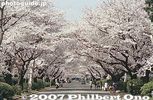
The middle of the campus has a long, straight road lined with cherries.
|
|

Buffet
|
|
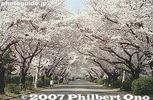
It's peaceful and quiet, and the cherries are stunningly beautiful when in full bloom.
|
|

Koto entertainment by Maiko, a well-known singer-songwriter from Shiga. 真衣子
|
|

Cherry blossoms tunnel
|
|

On the morning of Nov. 14, a boat cruise on the Michigan. Narration in both Japanese and English explaining about Lake Biwa's ecology. I was unable to join this cruise, so no photos.
|
|
|

In the afternoon of Nov. 14 was a "Youth Session," or panel discussion by representatives of various Kenjinkai overseas. They discussed about recruiting younger members and facilitating networking among members.
|
|
|
|

Questions from the audience were also taken.
|
|
|

Social Salon also served green tea and sweets.
|
|
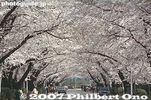
Sakura tunnel
|
|
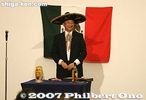
Mini presentation by the Biwako-no-Kai from Mexico.
|
|
|

Door prizes were given out in a drawing. There were so many prizes donated by various Kenjinkai that it took almost an hour to give them all out.
|
|
|
|

Final dinner on Nov. 14, 2007. Some wore happi coats or a kimono.
|
|
|

For the first hour (6 pm - 7 pm), we suffered through endless speeches by politicians. (Speeches should not be longer than 20 min. total at any event.)
|
|
|
|

Speech by Kunimatsu Yoshitsugu, Chairman of the Shiga Intercultural Association for Globalization.
|
|
|

Kunimatsu Yoshitsugu, Chairman of the Shiga Intercultural Association for Globalization. He is also the former Shiga governor.
|
|
|
|

Kanpai!
|
|
|

Food, finally! All from Shiga. Lots of fish, and funa-zushi too.
|
|

Cherry bicycles
|
|

Entertainment started with taiko drumming.
|
|
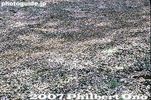
Don't forget to shoot the petals.
|
|

Governor Kada teaches us how to dance the Goshu Ondo, a native dance of Shiga. She spoke in both Japanese and English again. Also see the video at YouTube.
|
|

Petals
|
|

Almost everyone got up to dance the goshu ondo. It's like a bon dance peculiar to Shiga. Also see the video at YouTube.
|
|

Staged shot
|
|

Goshu ondo
|
|

Members of the Toronto Shiga Kenjinkai dance goshu ondo.
|
|

At the end, we sang Biwako Shuko no Uta (Lake Biwa Rowing Song). The party ended at 9:30 pm.
|
|
|

National flags
|
|

UN Pavilion
|
|

US Pavilion
|
|

US Pavilion Featuring Ben Franklin.
|
|

US Pavilion security check.
|
|

US Pavilion Ben Franklin movie.
|
|

US Pavilion display, Mars explorer replica.
|
|

US Pavilion display about flight.
|
|

US Pavilion attendant on a Segway.
|
|

Posing outside the US Pavilion.
|
|

Canada
|
|

Mexico
|
|

Bulgaria
|
|

Bulgaria
|
|

Spain (nice facade)
|
|

Italy
|
|

Italy (chocolate covered car)
|
|

Waiting times (Germany is popular with 2-hour waiting time).
|
|

Turkey
|
|

Nordic (Denmark, Sweden, Norway, Finland)
|
|

Nordic
|
|

Switzerland (Kanji character for "mountain.")
|
|

Austria
|
|

Czech Republic, another nice facade of wooden sticks.
|
|

Czech Republic
|
|

Russian Federation
|
|

UK
|
|

UK, a garden entrance path.
|
|

Poland
|
|

Poland (basket-like facade)
|
|

Poland
|
|

Poland
|
|

India
|
|

Malaysia
|
|

Malaysian dancers on outdoor mini stage.
|
|

Malaysian dancer
|
|

Malaysian dancer
|
|

Vietnam Pavilion
|
|

Vietnam
|
|

Cambodia
|
|

Cambodia, stone carving for sale.
|
|

South Pacific Islands
|
|

South Pacific Islander
|
|

South Pacific Islands
|
|

Indonesia
|
|

The Philippines (left) and Laos (right)
|
|

Laos
|
|

The Philippines
|
|

The Philippines, very nice aroma inside the pavilion.
|
|

Australia
|
|

Australia
|
|

Singapore
|
|

Global Common 6, an enclave of international pavilions.
|
|

June 24, 2007 Hikone VOICE World Gathering was an annual event of this international exchange group in Hikone. Held at Viva City Hall in Minami-Hikone.
|
|
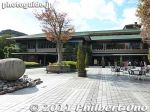
Kyoto International Community House (京都市国際交流会館) is near Keage Station on the Tozai subway line in Kyoto. It is near the famous Nanzenji temple, Keage Incline, and Lake Biwa Canal Museum.
|
|
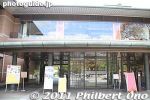
Front entrance of Kyoto International Community House, a municipal facility with event hall and conference rooms for rent and language/cultural classes for Kyoto's foreign community.
|
|
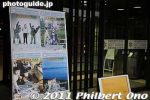
Near the front entrance is our signboard for Kyoto International Photo Showcase 2011 held during Nov. 16-20, 2011 featuring seven artists.
|
|
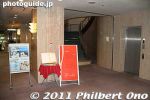
Inside the 1st floor of the Kyoto International Community House is a staircase and elevator going up to the 2nd floor. We had a signboard for our exhibition here too.
|
|
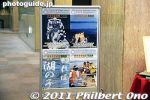
Our signboard next to the staircase and elevator going up to the 2nd floor.
|
|

The 2nd floor has the Sister Cities Exhibition Room where we held our group photo exhibition. This is a panorama shot of what our exhibition room looked like.
|
|

Another panorama shot of our exhibition room from a different corner of the room. The exhibition theme was "Home Sweet Hometown" or Furukiyoki Furusato.
|
|
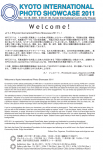
Welcome message to exhibition visitors.
|
|

We had seven artists showing their work. Six were American or Canadian, and one was Japanese. Three were from the Tokyo area, and the others live in Kyoto. The first wall showed these Oyako (Parent-child) portraits by Bruce Osborn.
|
|
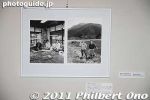
Bruce showed 12 portraits of his Oyako (Parent-child) portraits taken in Maibara, Shiga Prefecture which is next to Kyoto. The portraits were organized according to the four seasons starting with spring.
|
|

Bruce Osborn has been shooting Oyako portraits for 30 years. Many of them Japanese celebrities.
|
|
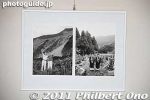
These portraits come from a larger exhibition at the Oyako Gallery in JR Maibara Station in northern Shiga Prefecture until March 2012.
|
|

The city of Maibara is pursuing a Kizuna campaign in reference to the bond (kizuna) with family and one's hometown. The city thus commissioned Bruce to shoot outstanding Oyako living in Maibara.
|
|
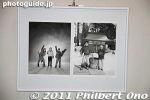
Oyako in winter. On the left is a portrait taken at Oku-Ibuki ski grounds and this Oyako operate the ski grounds.
|
|
|
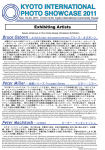
Bilingual biographies of Bruce Osborn, Peter Miller, and Peter MacIntosh.
|
|
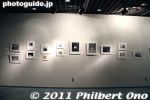
Next was Peter Miller's copperplate photogravures of furusato (hometown) scenes in Japan.
|
|
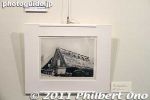
Peter Miller started his series with pictures of Shirakawa-go (Gifu Prefecture) in winter snow. The houses have steep, thatched roofs to dispel snow.
|
|
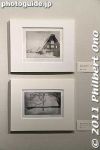
Shirakawa-go (Gifu Prefecture) in winter snow by Peter Miller.
|
|
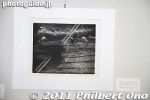
Rethatching a roof in Shirakawa-go, a World Heritage Site.
|
|
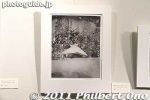
Snow in Muikamachi, Niigata.
|
|
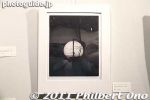
Meigetsuin temple in Kamakura with its famous moon-shaped window which opens to a Japanese garden. Also famous for hydrangeas in June.
|
|
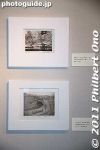
Bottom is a shot of Pittsburgh, PA taken when Peter was a young boy.
|
|
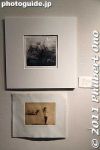
Peter Miller is one of the few artists who uses the traditional technique of copperplate photogravure. A copperplate is etched through a chemical process and then inked and pressed with paper to make prints.
|
|
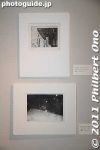
Kamakura temples. Peter lives in Kamakura.
|
|
|

Peter Miller explaining his work to visitors.
|
|
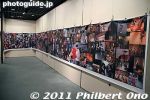
Canadian Peter MacIntosh is the Geisha Guru. He created a 13-meter-long montage of his Kyoto geiko/maiko photos. Ten years worth of 250+ photos.
|
|
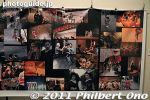
Peter MacIntosh's Kyoto geiko/maiko photos. A few photos were taken overseas when he took a few geiko for overseas events.
|
|
|
|
|
|
|

Standing here felt like you were surrounded by geisha.
|
|

Peter MacIntosh explains his work to visitors. See Peter's Web site at petermacintosh.com.
|
|
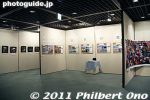
Next to the geisha photos was Philbert Ono's cove of photos introducing the Lake Biwa Rowing Song (Biwako Shuko no Uta).
|
|

Lake Biwa Rowing Song (Biwako Shuko no Uta) photos at Kyoto International Photo Showcase 2011 by Philbert Ono. I used eight large corkboards. First time to exhibit these photos in Kyoto.
|
|

Philbert showed photos visually depicting Shiga's most famous hometown song about a rowing trip around Japan's largest lake by a bunch of rowers from a Kyoto university rowing club.
|
|
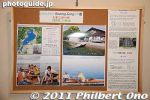
Photos of Verse 1. There are six verses, and each verse take you to a different place around the lake. Verse 1 starts in Otsu where the rowers departed in southern Lake Biwa.
|
|

Photos of Verse 2 (Omi-Maiko). Although this song is about rowing around Lake Biwa, it is also widely interpreted as a song about life itself.
|
|
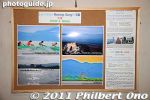
Verse 3. This verse is about a crossroads in life. It ponders over the question, "What do I want to do with my life?" Do we make life happen, or do we let life happen to us (rolling with the waves)?
|
|
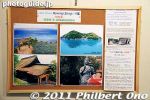
Verse 4. From Imazu, the boys rowed across the lake and most likely took a break at Chikubushima island in the middle of northern Lake Biwa. It has been a sacred island for centuries with Hogonji Buddhist temple (宝厳寺) first built in 724.
|
|
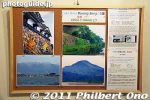
Verse 5. This is the only verse where the place is not specifically mentioned. The only hint is "old castle," which must be either Nagahama Castle or Hikone Castle.
|
|
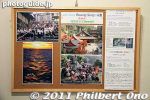
Verse 6. Rowing further down the eastern shore brings us to Omi-Hachiman, a old castle town and merchant town. One of its major temples is Chomeiji, dedicated to long life and good health and belonging to the Tendai Buddhist sect.
|
|
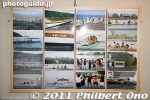
The eighth and last corkboard panel showed photos of various rowing clubs rowing around Lake Biwa. Imazu Jr. High Rowing Club, Kyoto University Rowing Club, and a FISA tour.
|
|

Visitors watch and hum along with the Lake Biwa Rowing music video on an iPad.
|
|
|

Kyoto-based John Wells showed large paintings based on photographs.
|
|
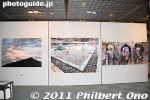
John Wells' large paintings of Mt. Hiei, Ryoanji, and the people on Japanese bills.
|
|
|

John Wells' oil painting of Mt. Hiei at dusk as seen from his window at home.
|
|
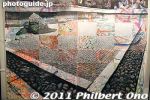
This work showing Ryoanji combines painting and photography. He made this painting just for this KIPS 2011 exhibition.
|
|
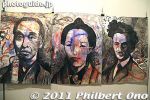
Faces we see on the 10000-yen, 5000-yen, and 1000-yen bills.
|
|
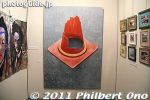
A large photo realistic painting of a broken traffic cone, also by John Wells.
|
|
|
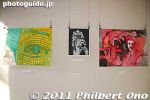
More work by John Wells.
|
|
|
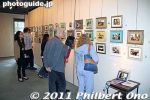
On a back wall, Micah Gampel showed numerous small self-portraits of himself at his friends' homes in a series titled, "My Furukiyoki Furusato is My Friends."
|
|
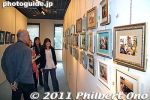
Many of the prints were taken especially for this exhibition, displayed for the first time.
|
|

Micah explains his photos to the crowd.
|
|
|
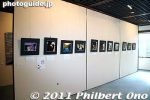
Motoyasu "Musashi" Matsutani showed scenic photos of Kyoto. These photos were also displayed the week before at a martial arts event in in Los Angeles, CA.
|
|

"I LOVE KYOTO" is the title of his photos.
|
|

Photos of Taizo-in temple, festivals, and people.
|
|
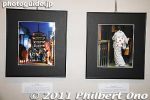
The photo of the back of a kimono woman was his favorite.
|
|
|
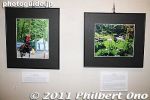
Yabusame
|
|
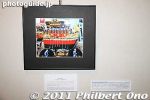
Gion Matsuri
|
|
|

A few pages from our Guest Book that visitors signed.
|
|
|
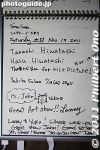
Thanks to all who visited our exhibition.
|
|

The Japan Grand Prix International Orchid Festival 2010 was held during Feb. 13-21, 2010 at Tokyo Dome. I attended this show for the first time on Feb. 20, 2010. Regular admission was 2,000 yen.
|
|

It was the show's 20th anniversary. The first show was held in 1991. Tokyo Dome's entire field was covered with orchids, orchid flower arrangements, orchid artwork, and stalls selling orchids.
|
|

There are six major categories including fragrance, flower displays, flower designs (Japanese and western arrangements), artwork (photos, paintings, etc.), and individual flowers. Huge crowds on weekends.
|
|

Main entrance to the floor exhibits.
|
|

The entrance leads to "Orchid Road."
|
|

Orchid Road
|
|

The best time to photograph the flowers is 10 min. before closing time (5:30 pm) when there are few people around.
|
|

Years Plates to mark the show's 20th anniversary. Each plate has 1,500 to 30,000 flowers.
|
|

The chairman of the show's organizing committee is Fukuhara Yoshiharu who is also the director of the Tokyo Metropolitan Museum of Photography and honorary chairman of Shiseido Cosmetics.
|
|
|

This year's Japan Grand Prix winner.
|
|

This year's Japan Grand Prix winner.
|
|

This year's Japan Grand Prix winner.
|
|

This year's Japan Grand Prix winner.
|
|

Besides the Grand Prix winner, there are many other awards, ribbons, and medals given to the best orchids.
|
|
|
|
|

Trophy Awards
|
|

Blue Ribbons for overseas winners.
|
|
|
|
|
|

There is an incredible vareity of orchids. Very exotic looking ones too.
|
|
|
|